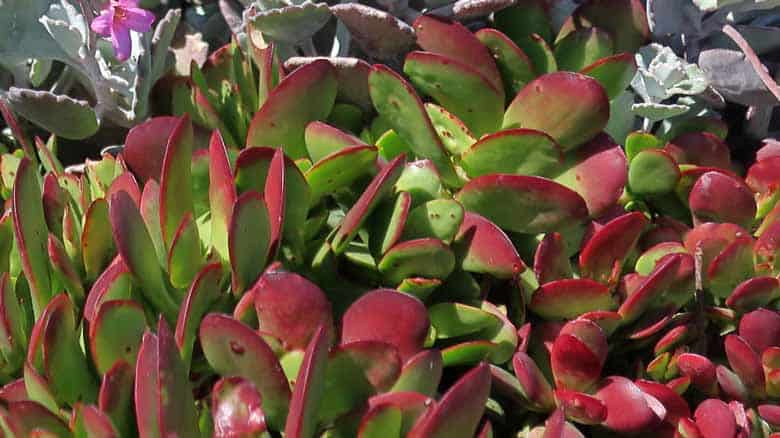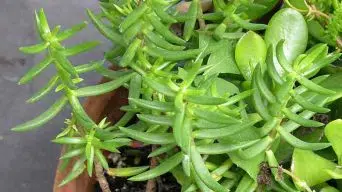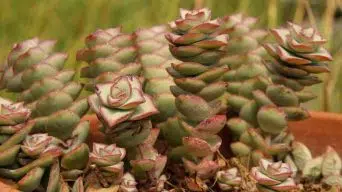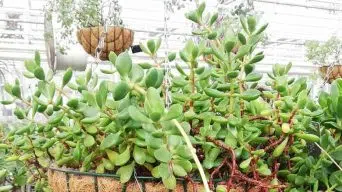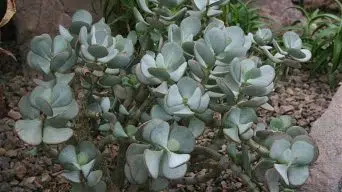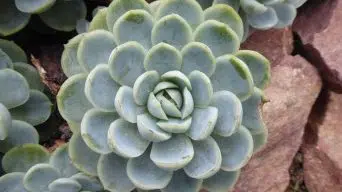The Crassula Platyphylla’ Burgundy’ is a succulent plant with thick, fleshy leaves.
The plants are native to South Africa. It is the only variety of the species that has burgundy-colored leaves.
This plant can grow into an attractive specimen in your home or garden with proper care and propagation!
In this article, you will learn everything you need to know about taking care of these plants and how to propagate them.
About the Crassula Nudicaulis var. Platyphylla’ Burgundy’
| Family: | Crassulaceae |
| Genus: | Crassula |
| Botanical Name: | Crassula nudicaulis var. platyphylla |
| Synonyms: | Crassula platyphylla |
| Common Names: | Crassula Burgundy |
| Origin: | South Africa |
| USDA Hardiness Zones: | 9 – 11 |
| Size: | 6 to o inches (15 to 20 cm) in height |
| Sun Exposure: | Full sun to partial shade |
| Water Needs: | Water thoroughly but infrequently |
| Soil Type: | Well-draining soil |
| Temperature: | 68° to 72ºF (20-22˚C) |
| Humidity Levels: | 40-60% |
The Crassula Nudicaulis var. Platyphylla’ Burgundy’ is a crassula plant with leaves with an attractive burgundy color.
This coloration is the result of anthocyanins, a type of pigment. The plant originates from South Africa and is often referred to as the “Burgundy Jade”.
It belongs to the family Asphodelaceae in its genus Crassulaceae and the species Nudicaulis.
The Crassula Platyphylla’ Burgundy’ is a slow-growing plant that only reaches about 15 to 20 cm (about six inches) in height.
The plant doesn’t develop an extensive root system and typically grows in dense clusters.
It also has small, light green leaves that are somewhat triangular with smooth edges.
How To Care for Crassula Platyphylla’ Burgundy’
Sun Exposure & Light Requirements
The Crassula Platyphylla will thrive in a position exposed to plenty of sun but does not tolerate full-sun exposure. Instead, this plant prefers partial shade and requires at least six hours daily.
A variegated Crassula Platyphylla plant will need to be placed in a location to receive direct and indirect sunlight.
The sun should not shine directly on the leaves for more than six hours per day, which is why this type of succulent prefers partial shade.
The amount of bright light exposure your Crassula Platyphylla Variegata needs will depend upon its location within an indoor space or garden area.
If it is in a location that receives only indirect light, the sun should not shine for more than six hours per day.
If it is indoors and receives no direct sunlight, you must place grow lights on it for at least 12 hours each day.
Watering Requirements
The Crassula Platyphylla Variegata plant needs to be watered at least once per week, and the soil should not be allowed to dry out.
Rainwater is preferred over tap water because it contains no chlorine or fluoride that could damage your plants.
If you prefer tap water, this can be diluted with distilled water before being used on your succulent leaves.
You will need a container that is big enough for the roots and leaves of your plant. In addition, it needs to be deep and wide so there is plenty of room for air to flow around.
The container should also have holes that allow excess humidity to escape around the roots while retaining enough for the plant to grow.
Soil Requirements
One of the essential things about succulent plants is soil.
Crassula Platyphylla succulents need a very well-draining mix in their pots so they don’t rot from too much water staying on them for extended periods.
There are many different types, but one popular choice is cactus potting soil or regular potting soil mixed with pumice and perlite (or any other similar mixture). This will give you an excellent mix that will drain quickly and stay nice and light because of all the air pockets created by the perlite.
But before planting your plant, add some compost, which will increase drainage even more!
Another benefit to using compost is that it’ll create better fertilizer for your plant once they grow and put out new leaves.
Temperature and Humidity
The ideal temperature for the Crassula Platyphylla plant is 68-72ºF. However, the temperature should not exceed 75° F or drop below 50° F.
Too much heat can cause the leaves to dry and turn brown, while too little will allow them to curl up.
With consistent temperatures like that, their succulent nature makes it easy to propagate.
This succulent does best in humid conditions, with around 60% relative humidity.
It’s essential that the plants are watered thoroughly but then allowed time for the potting mix to dry before watering again so they don’t become waterlogged.
The best place to grow these plants is indoors and in a pot with drainage holes and porous dry soil with enough organic material for the plant to thrive on.
You can also put them outdoors during the summer months if it is hot outside. Then, bring them back inside before nighttime temperatures drop below 50° F or before frost forms where you live.
Fertilizing
Fertilizing the Crassula Platyphylla is not required, but feeding the plants every two weeks during the growing season will help them produce more red leaves.
Using a commercial fertilizer designed for succulents and cacti with micronutrients or slow-release pellets is always best. It is less likely to burn your plant’s roots than liquid fertilizers.
You should dilute the fertilizer before applying it, as too much can harm your plant.
In larger containers, you may need to add an extra feed during the summer months – especially if there is no rainfall present and the soil gets dry quickly.
Water thoroughly first, then apply some fertilizer after waiting about ten minutes for nutrients on the surface of the dirt mix.
Repotting
The best time to repot a Crassula Platyphylla plant is summer.
Repotting should be done when new growth starts, usually in late winter or early spring.
The pot should have about three inches of space for Crassula plants with little growing room. Six-inch pots are recommended for healthy and active plants that will continue to grow larger.
Crassula Platyphylla plants are not the easiest to transplant, so be patient. Using a plastic pot and putting soil around it is best rather than squeezing it into an existing clay plant pot.
Make sure you don’t bury the stem of your Crassula in the dirt when you’re planting – leave at least two inches above ground level uncovered for photosynthesis!
During repotting, ensure there is enough room between each leaf on top of the soil surface; this will give air space, preventing rot from too much water retention.
If roots near leaf axils touch one another, you should gently untangle them before replanting them with sphagnum moss or charcoal added as
Pruning
Pruning is an excellent way to keep your plant healthy and looking its best.
You should prune any time the Crassula grows larger than desired or gets too leggy and stringy.
Leaving these plants unpruned will lead them to grow taller and wider to compete for sunlight.
Pruning encourages branching where it would not usually occur on this succulent species.
Allowing some of this growth can create new rosettes from which future cuttings can propagate more Crassulaceae plants.
- Cut back stems that have grown into each other or threaten to do so by removing the offending branch with sharp scissors at their base pair (where they meet).
- Remove wilted leaves from the plant and discard them to discourage pests such as whiteflies and mealybugs.
Pests
Crassulas are very resistant to pests. One of the most common problems is spider mites, which you can treat with horticultural soap or a natural insecticidal soap like neem oil.
Spider Mite infestations usually appear on new plants as small white dots on the leaves that turn into tiny webs in the plant’s crevices.
These should be wiped off gently with a wet cloth when they’re noticed before any damage occurs.
If an infestation has already happened:
- Pick off all affected leaves from the plant at ground level.
- Spray it down thoroughly with water (to remove any eggs).
- Use a small amount of horticultural soap or neem oil on the plant.
If you don’t have any of these oils, a diluted white vinegar solution might work just as well.
Be sure to rinse the plant thoroughly after application so that the soap doesn’t cause damage or mold growth.
The best way to prevent pests is by wiping off all dust and debris on new plants before bringing them home for use in your garden.
It would be best if you also made it a habit to check over open wounds periodically when working with Crassula (i.e., transplanting). Look for signs of infestation at those points.
Diseases
A common disease of Crassula is root rot, which can be caused by overcrowding or too much water.
If the leaves are going brown and falling off or signs of drooping over time in your crassula plant, it’s likely to suffer from root rot.
To combat this problem, ensure the soil is well-draining and only remains wet for a short period.
In extreme cases, you may need to replace the old potting mix with fresh new soil to revitalize your plant.
Crassulas can also get diseases like leaf spot, which is caused by fungus. They can also have rust if they get too much water. They may even have mildew if there’s a lot of humidity in your room.
To prevent these diseases, keep your plant in a well-ventilated area.
If you notice mold growing on the soil or leaves of your Crassula, there are likely too many nutrients available for the plants and not enough drainage happening.
To fix this problem, reduce watering until the roots have dried.
You can also add sand around the edge of pots with succulents. They don’t sit in wet soil when you water them. This may help prevent root rot from happening because they are overwatered.
How To Propagate Crassula Platyphylla’ Burgundy’
The Crassula Nudicaulis var. Platyphylla’ Burgundy’ can be propagated by taking cuttings from the main stem.
The process is straightforward:
- Take a cutting of at least one inch in length, and remove all the leaves except for two or three at the top.
- Place this cutting into a pot filled with soil mixed with perlite or vermiculite to help it retain moisture longer. Keep it moist but not wet, as too much water will cause rot on this succulent plant.
- Watch as new roots form within about six weeks and then carefully transplant them into their container when they are ready (usually after twelve months).
Crassula Platyphylla’ Burgundy’ can also be propagated by taking leaf cuttings and allowing them to callous over for a few days before placing them into the soil.
This process is very similar to the one described above.
You can also use seeds from the plant to propagate it.
- Fill a tray with cactus soil and sow seeds carefully, being sure not to cover them with too much soil at once, or they will rot.
- Place the tray in an area where it can be lightly shaded from direct sunlight for about half a day (though this is unnecessary).
- Mist them regularly until seedlings have formed roots that are long enough to reach a moist potting mix.
- Transplant them into individual containers filled with well-drained soil mix.
The time needed for germination varies but usually takes around two weeks if kept warm during those first few days after planting these succulent plants.
Is the Crassula Nudicaulis var. Platyphylla’ Burgundy’ Toxic?
The Crassula Platyphylla is a succulent plant that does not produce toxins for humans or animals to ingest.
However, this may be an issue if there are allergies to plants in the same family (Crassulaceae). They share many of the same proteins and other aspects with these related plants.
However, you should note that being allergic to one family member does not mean you will have an allergy to all members.
Final Thoughts
In conclusion, the Crassula Platyphylla succulent plant is an excellent addition to any succulent lover’s collection.
They are easy to care for and propagate, making them beautiful plants that will grow well in many different settings.
The plant is a good choice for people who live in apartments, as they are small and low maintenance.
They also work well as desk plants that need little bright sunlight since their leaves hang down from the soil to cover them during the day.
The Crassula Platyphylla succulent can be grown outdoors with enough sun exposure and protection against frost or wind damage.

